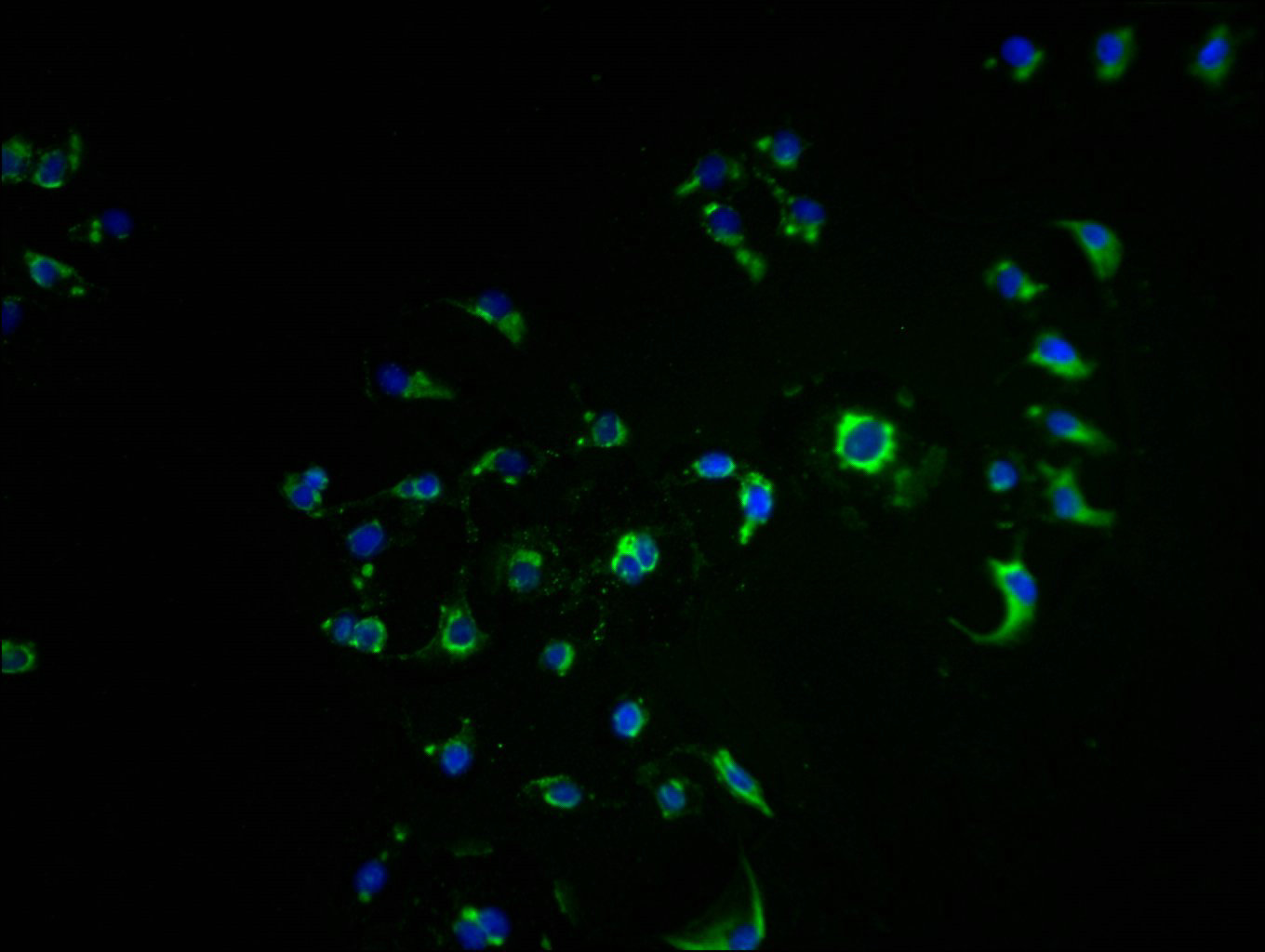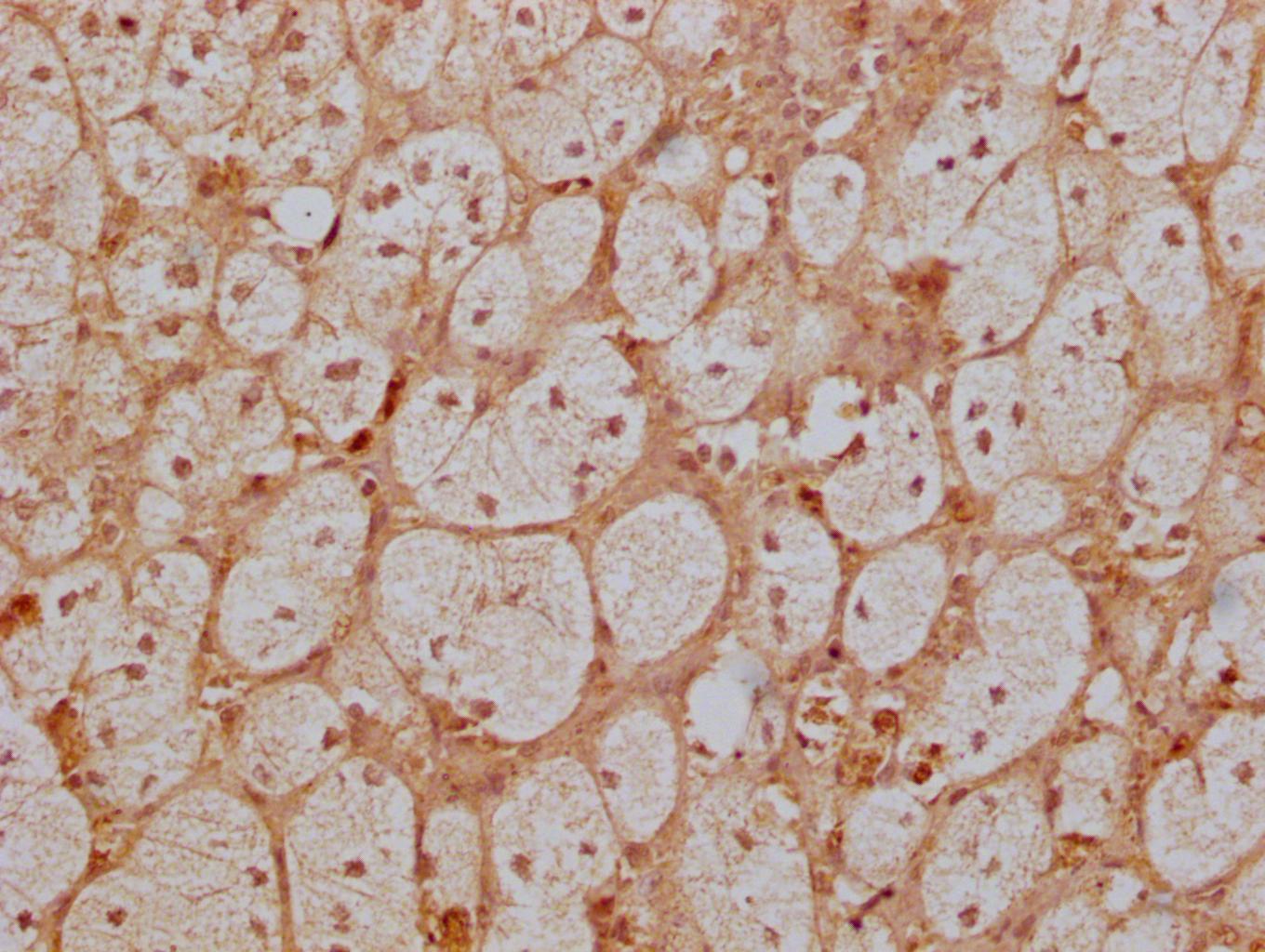FFAR3 Antibody
-
货号:CSB-PA008606LA01HU
-
规格:¥440
-
促销:
-
图片:
-
Immunofluorescence staining of A549 cells with CSB-PA008606LA01HU at 1:50, counter-stained with DAPI. The cells were fixed in 4% formaldehyde, permeabilized using 0.2% Triton X-100 and blocked in 10% normal Goat Serum. The cells were then incubated with the antibody overnight at 4°C. The secondary antibody was Alexa Fluor 488-congugated AffiniPure Goat Anti-Rabbit IgG(H+L).
-
IHC image of CSB-PA008606LA01HU diluted at 1:200 and staining in paraffin-embedded human adrenal gland tissue performed on a Leica BondTM system. After dewaxing and hydration, antigen retrieval was mediated by high pressure in a citrate buffer (pH 6.0). Section was blocked with 10% normal goat serum 30min at RT. Then primary antibody (1% BSA) was incubated at 4°C overnight. The primary is detected by a Goat anti-rabbit polymer IgG labeled by HRP and visualized using 0.05% DAB.
-
-
其他:
产品详情
-
产品描述:
The FFAR3 polyclonal antibody was obtained through three steps: immunizing a rabbit with the recombinant human FFAR3 (280-346aa), collecting and isolating antibodies from the rabbit serum, and purifying the resulting antibodies via protein G affinity chromatography. The purity of the FFAR3 polyclonal antibody is over 95%.
The function of the FFAR3 polyclonal antibody is to detect and bind to FFAR3 protein from human samples. The FFAR3 polyclonal antibody has been tested in a variety of applications, including ELISA, IHC, and IF, indicating its suitability for use in different experimental settings.
-
产品名称:Rabbit anti-Homo sapiens (Human) FFAR3 Polyclonal antibody
-
Uniprot No.:O14843
-
基因名:
-
别名:FFAR3; GPR41; Free fatty acid receptor 3; G-protein coupled receptor 41
-
宿主:Rabbit
-
反应种属:Human
-
免疫原:Recombinant Human Free fatty acid receptor 3 protein (280-346AA)
-
免疫原种属:Homo sapiens (Human)
-
标记方式:Non-conjugated
本页面中的产品,FFAR3 Antibody (CSB-PA008606LA01HU),的标记方式是Non-conjugated。对于FFAR3 Antibody,我们还提供其他标记。见下表:
-
克隆类型:Polyclonal
-
抗体亚型:IgG
-
纯化方式:>95%, Protein G purified
-
浓度:It differs from different batches. Please contact us to confirm it.
-
保存缓冲液:Preservative: 0.03% Proclin 300
Constituents: 50% Glycerol, 0.01M PBS, PH 7.4 -
产品提供形式:Liquid
-
应用范围:ELISA, IHC, IF
-
阳性对照:
FFAR3 Antibody shows positive results in ELISA, WB, IHC.
Showing positive signal in mouse kidney tissue through WB (western blot);
Showing right location in paraffin-embedded sections of human adrenal gland tissue through IHC (immunohistochemistry) -
推荐稀释比:
Application Recommended Dilution IHC 1:20-1:200 IF 1:20-1:200 -
Protocols:
-
储存条件:Upon receipt, store at -20°C or -80°C. Avoid repeated freeze.
-
货期:Basically, we can dispatch the products out in 1-3 working days after receiving your orders. Delivery time maybe differs from different purchasing way or location, please kindly consult your local distributors for specific delivery time.
相关产品
靶点详情
-
功能:G protein-coupled receptor that is activated by a major product of dietary fiber digestion, the short chain fatty acids (SCFAs), and that plays a role in the regulation of whole-body energy homeostasis and in intestinal immunity. In omnivorous mammals, the short chain fatty acids acetate, propionate and butyrate are produced primarily by the gut microbiome that metabolizes dietary fibers. SCFAs serve as a source of energy but also act as signaling molecules. That G protein-coupled receptor is probably coupled to the pertussis toxin-sensitive, G(i/o)-alpha family of G proteins. Its activation results in the formation of inositol 1,4,5-trisphosphate, the mobilization of intracellular calcium, the phosphorylation of the MAPK3/ERK1 and MAPK1/ERK2 kinases and the inhibition of intracellular cAMP accumulation. Activated by SCFAs and by beta-hydroxybutyrate, a ketone body produced by the liver upon starvation, it inhibits N-type calcium channels and modulates the activity of sympathetic neurons through a signaling cascade involving the beta and gamma subunits of its coupled G protein, phospholipase C and MAP kinases. Thereby, it may regulate energy expenditure through the control of the sympathetic nervous system that controls for instance heart rate. Upon activation by SCFAs accumulating in the intestine, it may also signal to the brain via neural circuits which in turn would regulate intestinal gluconeogenesis. May also control the production of hormones involved in whole-body energy homeostasis. May for instance, regulate blood pressure through renin secretion. May also regulate secretion of the PYY peptide by enteroendocrine cells and control gut motility, intestinal transit rate, and the harvesting of energy from SCFAs produced by gut microbiota. May also indirectly regulate the production of LEP/Leptin, a hormone acting on the CNS to inhibit food intake, in response to the presence of short-chain fatty acids in the intestine. Finally, may also play a role in glucose homeostasis. Besides its role in energy homeostasis, may play a role in intestinal immunity. May mediate the activation of the inflammatory and immune response by SCFAs in the gut, regulating the rapid production of chemokines and cytokines by intestinal epithelial cells. Among SCFAs, the fatty acids containing less than 6 carbons, the most potent activators are probably propionate, butyrate and pentanoate while acetate is a poor activator.
-
基因功能参考文献:
- FFAR2 and FFAR3 interact to form a heteromer in primary monocytes and macrophages via proximity ligation assay, and during heterologous expression in HEK293 cells via bimolecular fluorescence complementation and fluorescence resonance energy transfer. FFAR2 and FFAR3 may interact to form a receptor heteromer with signaling that is distinct from the parent homomers. PMID: 28883043
- Data suggest that cytokines TNFalpha and interleukin-1b markedly reduce GPR120/FFAR4 expression in adipocytes; in contrast, these cytokines induce expression of GPR84 and GPR41/FFAR3 in adipocytes. These studies were conducted in adipocytes cultured from subcutaneous adipose tissue. (GPR = G-protein coupled receptor; FFAR = free fatty acid receptor) PMID: 28835131
- a single dose of soluble fibre was able to significantly reduce airway inflammation in stable asthma by downregulating GPR43 and GPR41 PMID: 28075383
- Short-chain fatty acids lowered TNF-alpha-induced MCP-1 expression by reducing phosphorylation of p38 MAPK and JNK in a GPR41/GRP43-dependent manner in renal cortical epithelial cells. PMID: 28322790
- Our data suggest that GPR42 be reclassified as a functioning gene and that recognition of sequence and copy number polymorphism of the FFAR3/GPR42 complex be considered during genetic and pharmacological investigation of these receptors. PMID: 26260360
- FFAR3 is expressed in pancreatic beta cells and mediates an inhibition of insulin secretion by coupling to Gi-type G proteins. PMID: 25581519
- a significant correlation between a higher body mass index and lower methylation in the promoter region of FFAR3 in type 2 diabetes and obesity patients PMID: 24325907
- Extracellular ionic locks determine variation in constitutive activity and ligand potency between species orthologs of the free fatty acid receptors FFA2 and FFA3 PMID: 23066016
- GPR41 activation inhibits histone acetylation and cell growth. PMID: 22884094
- Selective orthosteric free fatty acid receptor 2 (FFA2) agonists: identification of the structural and chemical requirements for selective activation of FFA2 versus FFA3. PMID: 21220428
- characterization of GP41 in human tissue as a receptor for short chain fatty acids PMID: 12711604
- C2-C6 short-chain fatty acids, ligands of an orphan G protein-coupled receptor GPR41, stimulate leptin expression in both a mouse adipocyte cell line and mouse adipose tissue in primary culture PMID: 14722361
- GPR41 and 43 mediate SCFA signaling in mammary epithelial cells and thereby play an important role in their stress management. PMID: 16887331
- analysis of conserved polar residues in transmembrane domains V, VI, and VII of free fatty acid receptor 2 and free fatty acid receptor 3 are required for the binding and function of short chain fatty acids PMID: 18801738
- Results suggest that GPR41 expressed in human colonic mucosa may function as a sensor for luminal short-chain fatty acids. PMID: 19574715
- Study presents evidence showing that the six amino acid differences, including that R/W174 are polymorphisms rather than gene-specific differences between GPR41 and GPR42. PMID: 19630535
显示更多
收起更多
-
亚细胞定位:Cell membrane; Multi-pass membrane protein.
-
蛋白家族:G-protein coupled receptor 1 family
-
组织特异性:Highest level in adipose tissue, and lower expression across all tissues tested. Expressed in sympathetic ganglia.
-
数据库链接:
HGNC: 4499
OMIM: 603821
KEGG: hsa:2865
STRING: 9606.ENSP00000328230
UniGene: Hs.248055
Most popular with customers
-
-
YWHAB Recombinant Monoclonal Antibody
Applications: ELISA, WB, IF, FC
Species Reactivity: Human, Mouse, Rat
-
Phospho-YAP1 (S127) Recombinant Monoclonal Antibody
Applications: ELISA, WB, IHC
Species Reactivity: Human
-
-
-
-
-























